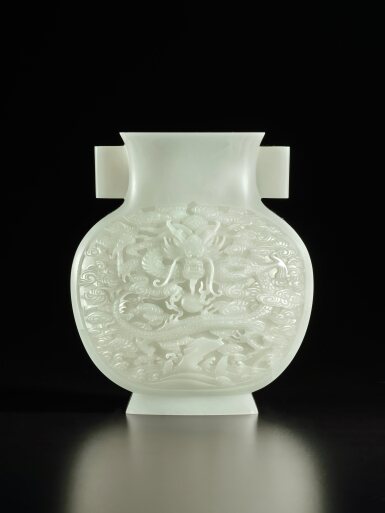Important Chinese Art
Important Chinese Art

Property from the Morgan Foundation Collection
A superbly carved white jade 'dragon' vase, Qing dynasty, Qianlong period | 清乾隆 白玉雕雲龍戲珠紋雙耳瓶
Auction Closed
September 21, 06:54 PM GMT
Estimate
800,000 - 1,200,000 USD
Lot Details
Description
A superbly carved white jade 'dragon' vase
Qing dynasty, Qianlong period
清乾隆 白玉雕雲龍戲珠紋雙耳瓶
Height 7⅛ in., 18.1 cm
Private Collection, acquired by 1925.
Christie's London, 14th May 2012, lot 80.
私人收藏,至1925年已入藏
倫敦佳士得2012年5月14日,編號80
Exquisitely carved, the present vase is testament to the technical perfection achieved by the imperial workshops during the reign of the Qianlong Emperor. The five-clawed dragons carved on each side, amidst scrolling clouds and enclosed within central medallions, are juxtaposed with the vase’s refined and simple form, subtly alluding to the unquestionable and imperial authority of the Qianlong Emperor.
During the Qing dynasty, especially during the reign of Qianlong, the production of imperial jade carvings in China soared to new heights. Through successful territorial expansion, political stability and soaring economic growth, the Empire acquired an unprecedented amount of wealth and the imperial workshops recruited the best artisans to cater to the increasing demands of the Emperor and the court. In 1759, the 24th year of Qianlong, the Qing Empire's victory over the Dzungar and Muslim rebellions marked a pivotal point in the production of jade carvings. The victory allowed access to the jade-rich territories in Khotan and Yarkant, where the geological setting was extremely favorable for the formation of high-quality nephrite. Khotan jade, renowned for its translucency and extreme hardiness, was highly prized. The Emperor’s passion for jade and the court’s access to unprecedented quantities of the raw material ushered in a new age of jade carving, pushing the craftsmen’s technical and creative capacities to new heights.
An erudite scholar and passionate collector of antiques, the Qianlong Emperor’s love for the past was grounded in his admiration for Chinese history and influenced by Confucian philosophy, which emphasized the study of history in the pursuit of virtue. The Qianlong Emperor actively influenced jade production, criticizing the ‘vulgar’ style popular in the 18th century as excessively ornate, and urged craftsmen to study ancient vessels to incorporate archaic elements into their own creations. The Xiqing gujian [Catalogue of Xiqing antiquities], which was compiled by court artists between 1749 and 1755, comprised line drawings of some 1,500 objects in the imperial collection, and was circulated among the craftsmen who were encouraged to take inspiration from it.
Skillfully adapted to suit the refined taste of the Emperor, the elegant form of this vase draws inspiration from archaic bronze wine vessels, hu, flanked with lug handles to each side. The robust shape of the bronze prototype was transformed into a graceful silhouette, acting as a canvas for the central medallions. The bold, powerful dragon carved in relief fills up the space, whereas the rest of the vase is void of decoration. The result is a vessel that appears modern yet steeped in classical symbolism.
Ferociously portrayed and coiled around the 'Flaming Pearl', the frontal dragon exerts its forceful presence. Able to control the rain and breathe clouds and fire in Chinese mythology, the dragon became associated with imperial power as early as the Han dynasty. From the Ming dynasty onwards, the imagery of a five-clawed dragon became inseparable from the association of imperial might. The fearsome portrayal of the dragon on the present vase is, thus, indicative of the artistic language adopted by the workshop to reinforce Qianlong’s rule as imperial, powerful, legitimate and ubiquitous.
Compare a closely related spinach-green jade vase and cover, in the National Palace Museum, Taipei (accession no. 故玉002725N000000000). Similarly carved with a five-claw dragon amidst the clouds in a central medallion, but with mythical beast handles suspending loose rings, the vase is inscribed with a six-character Daqing Qianlong fanggu mark to the base. For other closely related examples, see three covered vases, all with handles suspending loose rings, one formerly in the Collection of Hebert R. Bishop, now in the Metropolitan Museum of Art (accession nos 02.18.606a, b); another, previously in the Vint Family Collection, exhibited in International Exhibition of Chinese Art, Royal Academy of Arts, London, 1935, cat no. 2839, sold at Christie’s New York, 3th December 2008, lot 2606; the third, sold at Christie's London, 29th June 1959, lot 53. See one, lacking a cover, included in the 75th Anniversary Exhibition of Post-Archaic Chinese Jades from Private Collections, S. Marchant & Son, London, 2000, cat. no. 14. Lastly, a covered example of similar decoration, but with loose rings suspending from elephant-head handles, was sold at Christie’s New York, 2nd December 1989, lot 250.
本品白玉雲龍戲珠紋雙耳瓶,宮廷御作之美珍,上品佳器無疑,幾經精雕細琢,造工卓絕,奇思巧意,足見匠心。瓶身兩面各浮雕五爪龍紋,海水江崖,雲龍戲珠,與瓶身線條遙相呼應,內廷恭造之式十足,從側面彰顯了乾隆帝的無上權威。
清朝玉器製作到了乾隆一朝獨創新高。乾隆在位期間十全武功,捷戰連連,滿清版圖龐大,國庫殷實,宮廷御作廣招能人巧匠,以滿足皇帝與朝廷賞石惜玉的雅好。乾隆二十四年,清廷成功平息准噶爾部與回部之亂收復新疆,自此玉路大開。和闐與莎車盛產高質量玉料,而其中又以瑩潤透亮、剛硬堅韌的和闐玉最珍稀罕貴。乾隆對玉石之愛,加上驟然開通的玉石來源,使工匠的創意巧思得以實踐,玉雕技藝得以長足發展,踏進全新紀元。
乾隆素享聰慧博學美名,熟讀聖賢書,修史以習正道。乾隆尤其尚古,對清朝玉器風格發展影響深遠。乾隆認為當時盛行的玉雕風格過於繁複,俗不可耐,因而催使匠人研究古器,將其簡約之美及古樸之氣韻融入對玉器的設計。1749至1755年間編著的《西清古鑑》輯錄了超過1500件清宮所藏高古珍器,藝匠從中汲取靈感,融古通今。
本品器形取材自高古青銅壺,青銅壺身化為玉瓶上簡潔流麗的線條,瓶頸兩側飾貫耳,瓶身兩面以雲龍為飾,浮雕精緻生動,其餘均為素面。此瓶雖以傳統裝飾圖案為主,卻頗具現代設計韻味。
所飾正面雲龍,盤踞寶珠,張牙舞爪,雄偉矯健,威猛異常。在東方神話中,龍可呼風喚雨,騰雲駕霧,吞火吐焰,最早於漢朝已成為皇權象徵。明代以後,五爪金龍就與天子之尊密不可分。本品中雄偉兇悍的雲龍形象,體現了宮廷御作透過藝術語言,展現乾隆帝作為九五之尊、皇權天授的君主形象。
參考一相類乾隆碧玉龍紋蓋瓶,藏台北國立故宮博物院 (館藏編號:故玉002725N000000000),器身亦雕有騰雲五爪龍紋,獸首活環,底部刻「大清乾隆仿古」六字款。另見其他近例有三,均為帶耳活環蓋瓶。其一為畢紹普舊藏,現藏於紐約大都會藝術博物館 (館藏編號:02.18.606a, b);其二為Vint家族舊藏之御製白玉穿花八吉祥盤龍紋獸耳活環蓋瓶,展於《中國藝術國際展覽會》,皇家藝術學院,倫敦,1935年,圖編2839,並售於香港佳士得2008年12月3日,編號2606;其三則於倫敦佳士得成交,1959年6月29日,編號53。另有一無蓋例,展於《75th Anniversary Exhibition of Post-Archaic Chinese Jades from Private Collections》,馬錢特,倫敦,2000年,圖編14。亦可對比一例,紋飾相類,象耳活環,售於紐約佳士得1989年12月2日,編號250。
